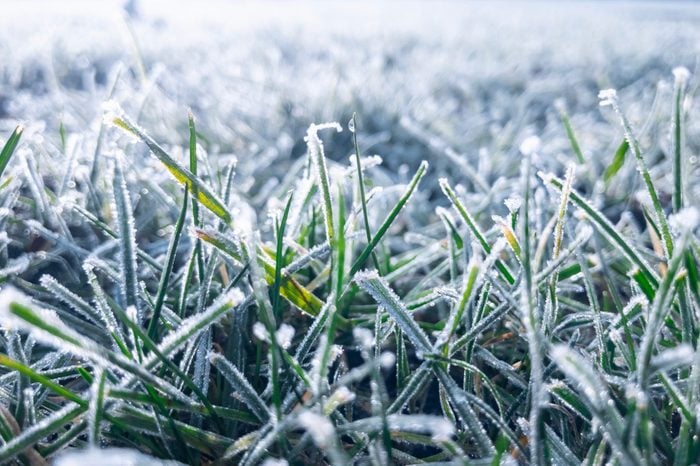What Happens To Grass During the Winter?
Updated: Dec. 15, 2023

Does grass grow in winter? As the cold sets in, winter seeding puts green in the bank, to be enjoyed when spring rolls around.
Yay! Cold mornings and raked leaves means lawn chores are finally over!
Or not.
If you’ve got scraggly turf or bare spots in your lawn, dormant seeding might be the ticket to producing a lush lawn next year, while reducing the headache of fighting spring weeds.
On This Page
Does Grass Grow in Winter?
It depends on where you live. If temperatures drop below 40 F, grass becomes dormant and doesn’t grow much, if at all. That means no mowing until spring.
Even if you live in a place that rarely experiences a hard frost — say, much of Florida — your grass will probably go into some degree of dormancy. It will grow, but more slowly, and it might not look as vibrant as it does when it’s warmer.
Can Grass Seed Survive Winter?
Yes, it often does. Spreading seed in late fall or early winter is called dormant seeding because it will not sprout until spring, especially if it’s covered with snow.
“Adding grass seed to the ground in late fall is best for when you want to reseed bare soil areas or thicken up a thin lawn,” says TurfMutt Foundation President Kris Kiser. “[But] if your lawn is already lush and dense, the grass seed you add has no way to get into the soil to germinate and grow in the spring.”
There’s one downside to dormant seeding: If the weather warms long enough for the grass to germinate, then freezes again, the new sprouts may not survive. Typically, grass needs a consistent soil temperature in the mid-50s F to germinate and grow, or daytime air temperatures in the 60s F and 70s F. If it does sprout and freeze, you will need to reseed the area.
If you live in an especially warm climate, like South Florida, regular seeding in spring and early summer often is a better option.
Which Grass Seed to Pick for Winter Seeding
Temperature, rainfall, humidity, sunlight, shade, soil composition and maintenance expectations all factor in when choosing which grass to plant. So it’s good to contact your local county extension office for the best advice for your locale. Also, check your U.S. Department of Agriculture Plant Hardiness Zone map to determine what kinds of grass and other plants grow best in your area.
In general, there are cool-season grasses for Northern and higher-elevation climates, and warm-season grasses for Southern and other warmer climates.
Common cool-season grasses include:
- Kentucky bluegrass;
- Fine fescue;
- Tall fescue;
- Perennial ryegrass.
These grasses will germinate earlier in cold soils, so they’ll develop faster than seeds sown in spring. That is particularly helpful for thickening lawns before weeds start to grow. It also gives grass an advantage in densely shaded areas, because it can get established before spring foliage emerges.
Common warm-season grasses include:
- Bermudagrass (which also has high salt tolerance);
- Buffalograss;
- Blue grama;
- Zoysiagrass.
If you live in a middle climate, Kiser suggests a blend of warm and cold-season grasses.
Dormant Seeding Tips
Dormant seeding is typically done once temperatures are low enough to prevent germination until spring. In cooler regions, this means sometime in October or November, after the last of the leaves have been raked up. Ideally, the ground will not be frozen, just cold enough to prevent sprouting.
- Think about moisture. “Check the weather forecast and try to sow seeds shortly before a snowstorm or heavy rain,” says Kiser.
- Remove excess yard waste. “The most important thing to keep in mind is that you are trying to achieve soil to seed contact,” he says. “So if you are adding seed to a lawn with heavy thatch, this needs to be raked away.”
- Spread the seeds evenly by hand. If you have a large area to cover, try a seeder or spreader. “Try not to place the seeds to close together so seedlings do not have to fight for resources,” Kiser says.
- Follow the instructions on the seed bag.
Over the winter, freezing and thawing will help the seeds work into the soil. You’ll know if it worked by mid- to late-spring. At that point, if it’s looking a little thin, add more seed.
Winter Lawn Care Tips
Mostly, from here on out it’s all about sitting back and enjoying the winter season. You may need to prevent winter weeds. Just two more bits of advice:
- Avoid putting snow melting and rock salt products on the lawn. Instead, opt for plant-friendly de-icing products.
- Avoid walking on your lawn too much in the winter, which can damage frozen grass. “Usually only the top part of the grass blade will snap off and the rest of the grass will be fine,” says Kiser. “But steps on a brittle lawn can leave an unsightly look.”
